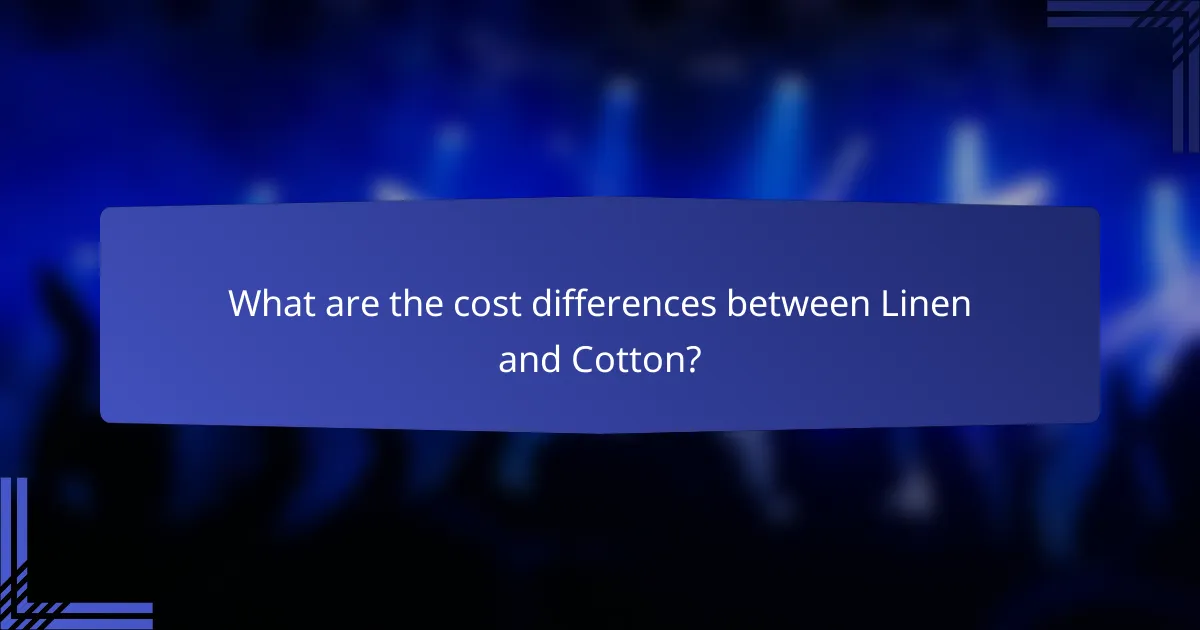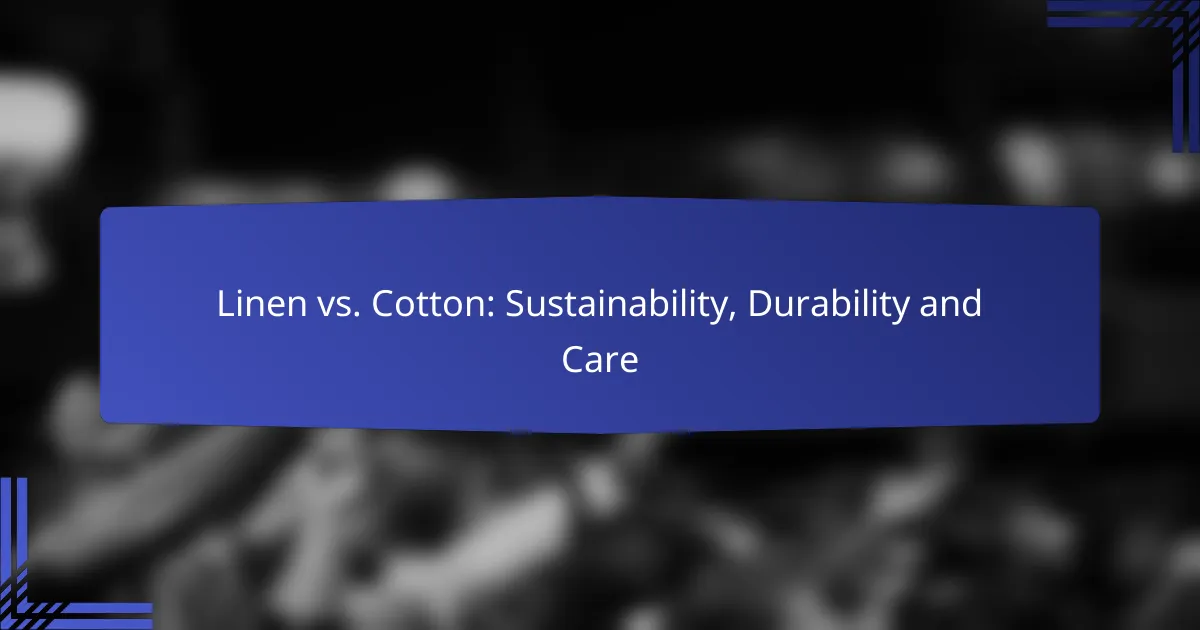When comparing linen and cotton, sustainability, durability, and care are key factors to consider. Linen is often regarded as the more eco-friendly option due to its lower resource requirements, while its stronger fibers contribute to greater durability compared to cotton. Additionally, each fabric has unique care needs that can impact their longevity and appearance, making it essential to understand these differences for effective maintenance.

Which fabric is more sustainable: Linen or Cotton?
Linen is generally considered more sustainable than cotton due to its lower resource requirements and environmental impact. While both fabrics have their benefits, linen’s cultivation process is less taxing on water supplies and ecosystems.
Linen has lower water usage
Linen production requires significantly less water compared to cotton. Growing flax, the plant used to make linen, can thrive in dry conditions and often relies on rainwater, while cotton typically needs extensive irrigation, especially in regions with less rainfall.
This lower water usage not only conserves vital resources but also reduces the risk of water pollution from agricultural runoff, making linen a more eco-friendly choice for consumers concerned about water sustainability.
Cotton requires more pesticides
Cotton farming is heavily reliant on pesticides to combat pests and diseases, which can lead to soil degradation and water contamination. In contrast, flax plants used for linen are more resilient and often require fewer chemical inputs.
This reduced reliance on pesticides makes linen a safer option for both the environment and the health of farmworkers, as it minimizes exposure to harmful chemicals.
Linen is biodegradable
Linen is fully biodegradable, meaning it can decompose naturally without harming the environment. This characteristic allows linen products to break down over time, returning nutrients to the soil.
In contrast, cotton can also be biodegradable, but the presence of synthetic dyes and treatments can complicate this process, potentially leading to longer decomposition times.
Cotton has a higher carbon footprint
The carbon footprint of cotton is generally higher than that of linen due to the energy-intensive processes involved in its cultivation and processing. Cotton farming often contributes to greenhouse gas emissions through extensive use of machinery and fertilizers.
Linen, on the other hand, typically has a lower carbon footprint, as its production involves less energy and fewer inputs, making it a more climate-friendly fabric choice for environmentally conscious consumers.

How do Linen and Cotton compare in durability?
Linen generally outperforms cotton in durability due to its stronger fibers and resistance to wear. While both fabrics have their merits, linen’s structural integrity makes it a better choice for long-lasting textiles.
Linen is more resistant to wear
Linen fibers are naturally stronger and more resilient than cotton, which allows linen garments and home textiles to withstand frequent use and washing. This durability means that linen items can last for years, often becoming softer and more comfortable over time without losing their shape.
Additionally, linen’s ability to wick moisture and dry quickly helps prevent mildew and odor, further extending the lifespan of the fabric. For those seeking sustainable options, the longevity of linen contributes to its overall eco-friendliness, as fewer replacements are needed.
Cotton is prone to fading
Cotton, while soft and comfortable, is more susceptible to fading and wear over time, especially when exposed to sunlight and frequent washing. This can lead to a noticeable decline in appearance, making cotton less ideal for items that require a pristine look for extended periods.
To mitigate fading, consider washing cotton in cold water and avoiding prolonged sun exposure. Choosing high-quality cotton with a tighter weave can also help maintain its color and durability, but it may still require more frequent replacement compared to linen products.

What are the care requirements for Linen and Cotton?
Linen and cotton have distinct care requirements that affect their longevity and appearance. Understanding these differences can help you maintain your fabrics effectively and prolong their life.
Linen requires gentle washing
Linen is a delicate fabric that benefits from gentle washing methods. It is best to wash linen in cold water on a gentle cycle to prevent damage and maintain its natural fibers.
Avoid using harsh detergents or bleach, as these can weaken the fabric. Instead, opt for mild, eco-friendly detergents to preserve the integrity of the linen.
Cotton can withstand higher temperatures
Cotton is more durable than linen and can typically withstand higher washing temperatures. Washing cotton in warm or hot water can help remove stains and allergens effectively.
However, be cautious with colored cotton items, as hot water may cause fading. For best results, follow the care label instructions, and consider air drying to prevent shrinkage.

What are the cost differences between Linen and Cotton?
The cost differences between linen and cotton primarily stem from their production processes and material qualities. Linen is generally more expensive due to its labor-intensive manufacturing and the limited availability of flax plants, while cotton offers a wider range of budget-friendly options.
Linen is generally more expensive
Linen typically costs more than cotton, often ranging from 20% to 50% higher depending on quality and brand. The higher price reflects the extensive labor required to harvest and process flax fibers, as well as the durability and longevity of linen products.
When considering linen, it’s important to factor in its lifespan. Although the initial investment is higher, linen’s durability can lead to cost savings over time, as it often outlasts cotton in everyday use.
Cotton offers budget-friendly options
Cotton is widely available and comes in various price ranges, making it accessible for most budgets. Basic cotton items can be found at low prices, while premium cotton varieties, such as Egyptian or Pima cotton, may cost more but still generally remain less expensive than linen.
For those looking to save, consider shopping during sales or choosing blends that combine cotton with other fibers. This can provide a balance of comfort and affordability while still offering good quality for everyday use.

How do Linen and Cotton affect skin sensitivity?
Linen is generally more suitable for sensitive skin compared to cotton. Its natural fibers and hypoallergenic properties make it less likely to cause irritation, while cotton can sometimes provoke reactions in individuals with skin sensitivities.
Linen is hypoallergenic
Linen is made from the flax plant and has a unique structure that allows it to breathe and wick moisture away from the skin. This quality helps to reduce the risk of irritation and allergic reactions, making it a great choice for those with sensitive skin. Additionally, linen is less likely to harbor dust mites and other allergens.
For individuals prone to allergies or skin conditions, choosing linen garments can lead to a more comfortable wearing experience. It is often recommended for bed linens and clothing for those who experience eczema or other skin sensitivities.
Cotton can irritate sensitive skin
Cotton, while soft and comfortable, can sometimes irritate sensitive skin due to its tendency to absorb moisture and harbor bacteria. This can lead to discomfort, especially in humid conditions. Some cotton fabrics are treated with chemicals during processing, which may also trigger allergic reactions in susceptible individuals.
When selecting cotton products, look for organic options that are free from harsh chemicals. Additionally, consider the weave and thickness of the fabric, as lighter, looser weaves may be less irritating than heavier, tightly woven cottons.

What are the environmental impacts of Linen and Cotton production?
The environmental impacts of linen and cotton production vary significantly, with linen generally being more sustainable. Linen, derived from the flax plant, requires less water and pesticides compared to cotton, which is often associated with higher resource consumption and chemical use.
Linen has a lower environmental impact
Linen production typically has a lower environmental footprint than cotton due to its cultivation process. Flax plants, from which linen is made, can thrive in poor soil conditions and require minimal irrigation, making them less demanding on water resources.
In contrast, cotton farming often involves extensive use of water and pesticides, contributing to soil degradation and water scarcity in many regions. For example, it can take around 7,000 to 29,000 liters of water to produce just one kilogram of cotton, depending on the farming practices used.
Choosing linen over cotton can be a more eco-friendly option. Look for certifications like the Global Organic Textile Standard (GOTS) for cotton, which ensures organic practices, but remember that linen generally has a more favorable environmental profile overall.
